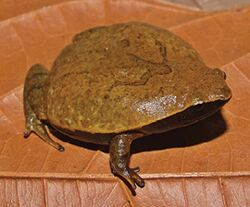Biology:Stereocyclops
| Stereocyclops | |
|---|---|

| |
| S. histrio | |
| Scientific classification | |
| Domain: | Eukaryota |
| Kingdom: | Animalia |
| Phylum: | Chordata |
| Class: | Amphibia |
| Order: | Anura |
| Family: | Microhylidae |
| Subfamily: | Gastrophryninae |
| Genus: | Stereocyclops Cope, 1870 |
| Type species | |
| Stereocyclops incrassatus Cope, 1870 "1869"[1]
| |
| Species | |
|
4, see text. | |
| Synonyms[2] | |
|
Emydops Miranda-Ribeiro, 1920 | |
Stereocyclops (common name: Brazilian dumpy frogs) is a small genus of microhylid frogs.[2][4] It is endemic to the Atlantic forest of eastern Brazil .[2] Molecular phylogeny suggests that it is sister taxon to the clade containing Dasypops and Myersiella.[5]
Description
Stereocyclops can be defined by features of its osteology. In the skull, palatine bone is present, as is the posterior part of prevomer. The clavicle is fully developed and long. Furthermore, the dorsal coloration is light and sharply separated from the dark ventrum by a light line. The head is flattened and the mouth is relatively large.[3] Notice, however, that at the time of this description, the genus was monotypic and Hyophryne was considered a separate genus;[3] a thorough morphological study of the genus as presently understood is lacking.[6]
Beheavior
One species, Stereocyclops parkeri, is known to show defensive behavior that may enhance its cryptic appearance, giving an impression of a casually dislodged leaf: when an individual is disturbed, it makes a short leap, landing with its legs stretched backwards. It will then remain still, sometimes as long as 30 minutes, although it may also move a little forward with a quick movement of the feet, resembling a flicked leaf.[7]
Species
There are four species in the genus:[2][4]
| Binomial name and author | Common name |
|---|---|
| Stereocyclops histrio (Carvalho, 1954) | Bahia yellow frog |
| Stereocyclops incrassatus Cope, 1870 | Brazilian dumpy frog |
| Stereocyclops palmipes Caramaschi, Salles, and Cruz, 2012 | |
| Stereocyclops parkeri (Wettstein, 1934) |
References
- ↑ Cope, Edward D. (1870). "Seventh contribution to the herpetology of tropical America". Proceedings of the American Philosophical Society 11 (81): 147–192.
- ↑ 2.0 2.1 2.2 2.3 Frost, Darrel R. (2017). "Stereocyclops Cope, 1870". Amphibian Species of the World: an Online Reference. Version 6.0. American Museum of Natural History. http://research.amnh.org/vz/herpetology/amphibia/Amphibia/Anura/Microhylidae/Gastrophryninae/Stereocyclops.
- ↑ 3.0 3.1 3.2 Carvalho, Antenor Leitão de (1954). "A preliminary synopsis of the genera of American microhylid frogs". Occasional Papers of the Museum of Zoology, University of Michigan 555: 1–19.
- ↑ 4.0 4.1 "Microhylidae". AmphibiaWeb. University of California, Berkeley. 2017. http://www.amphibiaweb.org/lists/Microhylidae.shtml.
- ↑ de Sá, R. O.; Streicher, J. W.; Sekonyela, R.; Forlani, M. C.; Loader, S. P.; Greenbaum, E.; Richards, S.; Haddad, C. F. B. (2012). "Molecular phylogeny of microhylid frogs (Anura: Microhylidae) with emphasis on relationships among New World genera". BMC Evolutionary Biology 12: 241. doi:10.1186/1471-2148-12-241. PMID 23228209.
- ↑ Caramaschi, U.; Salles, R. de O. L.; Cruz, C. A. G. (2012). "A new species of Stereocyclops Cope (Anura, Microhylidae) from southeastern Brazil". Zootaxa 3583: 83–88. doi:10.11646/zootaxa.3583.1.7.
- ↑ Sazima, Ivan (1978). "Convergent defensive behavior of two leaf-litter frogs of southeastern Brazil". Biotropica 10 (2): 158. doi:10.2307/2388020.
Wikidata ☰ Q2217761 entry
 |

